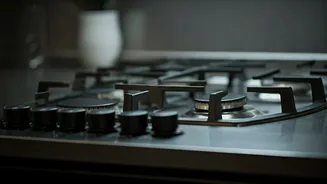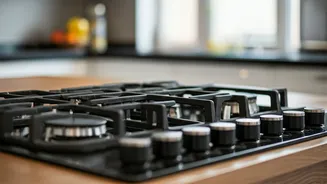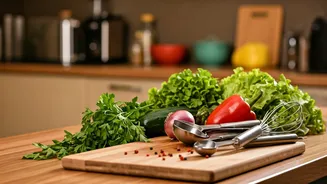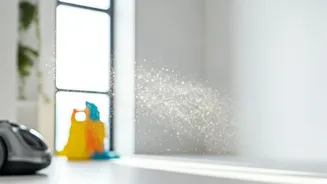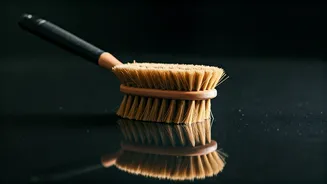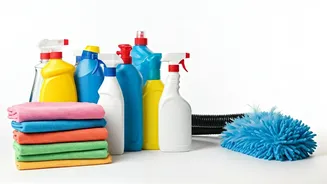Grasping the Basics
Gas stoves, central to any kitchen, often gather grease, food splatters, and spills. A clean stove not only looks great but also ensures efficient, safe
cooking. It's crucial to understand the components – burners, grates, and the cooktop itself – to clean each effectively. Regular cleaning prevents food from burning onto surfaces, making future cleaning easier and maintaining the appliance's longevity. Remember to turn off the gas supply and let the stove cool down before starting any cleaning process. Safety is paramount; this precaution prevents burns and accidental gas leaks. With the proper approach, cleaning your stove becomes a manageable task, contributing to a pleasant cooking environment.
Gathering Your Arsenal
Before commencing cleaning, assemble the necessary materials. You'll require mild dish soap, warm water, a soft sponge or cloth, and potentially a non-abrasive cleaner for tougher stains. Avoid abrasive scrubbers or harsh chemicals, as these can damage the stove's finish. Microfiber cloths are ideal for wiping surfaces without leaving streaks. For removing caked-on food, consider a plastic scraper or a soft-bristled brush. Additionally, baking soda paste—a mixture of baking soda and water—is excellent for scrubbing stubborn areas. White vinegar, known for its cleaning abilities, can be used diluted in water to remove grease. Always test any cleaner on a small, inconspicuous area first to ensure it doesn't cause discoloration or damage. Properly preparing your cleaning kit simplifies the cleaning process, making it quicker and more efficient.
Cleaning the Burners
The burners are crucial to the stove’s performance, and cleaning them regularly is essential. First, remove the burner caps and grates. These pieces usually can be washed with warm, soapy water. Use a soft brush to remove any food particles lodged in the burner ports. Rinse thoroughly and ensure they are entirely dry before reassembling them. For heavily soiled burners, create a baking soda paste and apply it, allowing it to sit for a few minutes before scrubbing gently. If your burners are not igniting correctly, check for obstructions in the ports with a small pin or wire. Never use excessive force, and be cautious when handling them to avoid damage. Clean burners ensure consistent heat and efficient cooking; maintaining them will also improve the stove's performance over time.
Tackling the Grates
The grates accumulate significant grease and grime. Begin by soaking them in hot, soapy water for some time. This softens the residue, making it easier to remove. Alternatively, you can use the baking soda paste or a commercial degreaser, following the product's instructions. For particularly stubborn stains, leave the grates to soak overnight. After soaking, scrub them with a non-abrasive pad or brush, and rinse thoroughly with water. Dry the grates completely before placing them back on the stove. Ensuring grates are clean and dry prevents rust and keeps them in good condition. Clean grates also provide a stable and sanitary surface for cooking.
Wiping the Cooktop
Cleaning the cooktop itself involves several steps. Begin by wiping the surface with a damp cloth to remove loose debris. Apply a mild dish soap solution or a suitable cleaner to the surface. Gently wipe down the cooktop, ensuring you cover all areas, paying close attention to the spots around the burners and any spills. For stubborn spots or burnt-on food, let the cleaner sit for a short period before scrubbing. After cleaning, thoroughly wipe the cooktop with a clean, damp cloth to remove any soap residue. Finally, dry the surface with a clean, dry cloth to prevent streaks. Regular cleaning of the cooktop helps in maintaining its appearance and prevents the build-up of grime, which can be difficult to clean later.
Advanced Cleaning Tactics
For hard-to-remove stains, explore advanced techniques. For instance, creating a paste of baking soda and vinegar and applying it to tough areas, allowing it to sit for a while, then scrubbing. The vinegar and baking soda reaction can help loosen stubborn residue. Another method involves using a commercial degreaser designed for kitchen appliances, carefully following the product instructions. If food has been burnt onto the surface, a plastic scraper can gently lift it without damaging the surface. Remember, use these techniques cautiously, and always test a small, hidden area first. Consistent use of these advanced tactics will keep your stovetop spotless.
Preventative Maintenance
Maintaining your gas stove involves more than just cleaning; it's about adopting preventative measures to reduce the need for deep cleaning. Clean spills immediately to prevent them from hardening and sticking to the surface. Using stovetop protectors or liners can help catch spills and splatters, simplifying cleaning. Place a heat-resistant mat or pad under pots and pans to prevent scratches. When cooking, monitor food closely to prevent boil-overs and splatters. Regularly inspect burners and grates for any signs of damage or wear. Taking such measures ensures that your stove remains in excellent condition. This approach saves time and effort in the long run.
